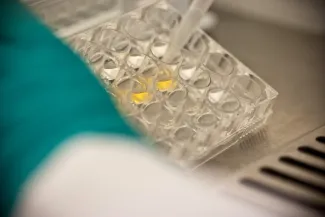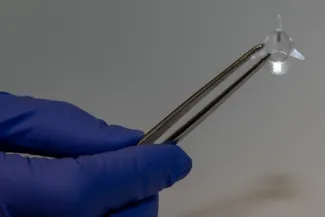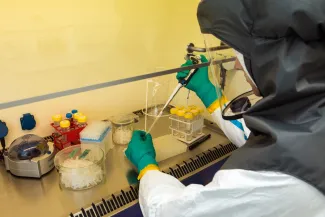Platform for inhalation tests reduces need for animal testing
Animal testing is still frequently used to test the safety and effectiveness of medicines and other chemical substances. Alternative methods can reduce the need for such testing, for instance, because they are based on cultured human cells (in vitro). VITO designed a test platform specifically for inhaled substances. Together with the Rega Institute at KU Leuven, the platform was used to investigate whether remdesivir, used to treat Covid-19, can also be administered through the airways.

Remdesivir is an antiviral medicine that was developed years ago to fight the feared Ebola virus. However, this virus inhibitor only gained wide attention when it was also used for infections with SARS-CoV-2 during the first outbreaks of Covid-19. Since then, remdesivir has been used to treat high-risk Covid-19 patients. It’s always administered through an injection in the arm (intravenous).

However, virologists believe that remdesivir could be more effective if inhaled. ‘The virus inhibitor can reach its target, the lungs, faster and more directly, without having to make a detour via the bloodstream,’ says Dirk Jochmans, virologist at the Rega Institute. ‘This offers the prospect of a more effective treatment, especially for high-risk Covid-19 patients.’ The current formulation of remdesivir means intravenous administration is only possible in a hospital. This is due to the pharmacokinetic properties of the active molecule, which determine how it behaves in the body. As a result, remdesivir cannot be inhaled in the early stage of the disease at the patient’s home.
Lung cells on a membrane
The test platform at VITO is designed around in vitro systems developed to expose lung cells to a substance via the air. This is called the air-liquid interface (ALI) exposure method. The lung cells are grown on a membrane. They are fed with cell culture medium from underneath, and come into contact with the airborne substances being tested from above. VITO uses various ALI exposure modules, aerosol generation systems (for dry powders and liquids), and instruments for aerosol and biological characterisation. VITO also uses various lung-cell systems: monoculture and co-culture cell compositions, and lung cells from human donors.
This test platform allows research into the potentially beneficial approach of administering remdesivir via the airways (such as asthma patients using a puffer). A research plan was drawn up with the virologists at the Rega Institute. Two different methods of administering remdesivir were compared. Firstly, the traditional method of adding remdesivir to the nutrient medium (from underneath) of the infected cells, to mirror intravenous administration. Secondly, administrating remdesivir by applying a fine spray on top of the infected cells (nebulizer), to mirror inhalation. The research revealed that administrating remdesivir via nebulizer has an effective antiviral effect, so there may well be potential for easier administration of this drug in the early stages of disease.
Besides its usefulness for this remdesivir research, the in vitro testing platform is suitable for much wider use, and may even be useful for applications outside the area of medicine. Sandra Verstraelen of VITO: ‘Our platform is suitable for all kinds of situations. It can be used for testing and developing drugs, but also for nano particles, ultra-fine particles, chemical substances, micro-plastics and nano-plastics. Basically, anything that involves exposure to lung cells via inhalation.’ This means the platform also has significant potential to reduce the number of animal experiments. In general, it’s estimated that ~2 million animals are used in laboratories worldwide for inhalation testing. Better in vitro screening and prioritisation could significantly reduce this figure.

Separating the wheat from the chaff
The advantage of testing on human cells is that it’s easier to estimate the potential effects in human patients. After all, what works in mice doesn’t necessarily has the same effect in humans. However, this doesn’t mean the end of animal testing in research into new substances, or new methods of administration, such as the example cited with remdesivir. ‘Animal testing remains indispensable to test the safety of a potential medicine,’ according to Jochmans. ‘This is the only way we can detect unknown effects at the level of the entire organism, for example, something not yet possible with cell culture alone.’
In vitro platforms such as VITO’s mainly reduce the need for animal testing because they allow us to separate the wheat from the chaff much more quickly in the early stages of the development of new substances. At these early stages, effectiveness is the main concern. Jochmans: ‘In the initial stages, many potential formulations are quickly dropped out. If this selection process improves through the use of advanced human cell cultures, fewer substances will have to be tested on laboratory animals.’ It would also save time, an incentive for the industry to use such platforms. In any case, the research with the inhaled remdesivir has proven that this platform is ready.
The remdesivir inhalation testing project was co-financed by the Animal Welfare Department of the Environmental Department. It’s part of the Flemish government’s ambition to reduce the use of laboratory animals, through different approaches such as the development of alternative test methods.
Below you can watch a video about the in vitro platform for inhalation testing.



